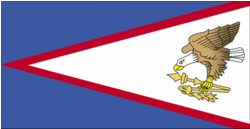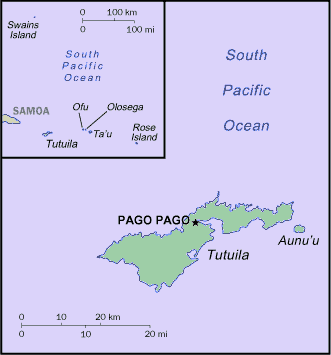Traveling Luck for American Samoa. American Samoa, Oceania
American Samoa is located in Oceania, group of islands in the South Pacific Ocean, about half way between Hawaii and New Zealand.
Land in American Samoa is five volcanic islands with rugged peaks and limited coastal plains, two coral atolls (Rose Island, Swains Island).
American Samoan land covers an area of 199 square kilometers which is slightly larger than Washington, DC
 American Samoan national flag (Flag of American Samoa)
American Samoan national flag (Flag of American Samoa)
As for the American Samoan climate; tropical marine, moderated by southeast trade winds; annual rainfall averages about 3 m; rainy season (November to April), dry season (May to October); little seasonal temperature variation.
American Samoan(s) (US nationals) speak Samoan 90.6% (closely related to Hawaiian and other Polynesian languages), English 2.9%, Tongan 2.4%, other Pacific islander 2.1%, other 2%
note: most people are bilingual (2000 census).
Places of note in American Samoa
 American Samoan map
American Samoan map
Regions of American Samoa
Settled as early as 1000 B.C., Samoa was "discovered" by European explorers in the 18th century. International rivalries in the latter half of the 19th century were settled by an 1899 treaty in which Germany and the US divided the Samoan archipelago. The US formally occupied its portion - a smaller group of eastern islands with the excellent harbor of Pago Pago - the following year.
American Samoa has a traditional Polynesian economy in which more than 90% of the land is communally owned. Economic activity is strongly linked to the US with which American Samoa conducts most of its foreign trade. Tuna fishing and tuna processing plants are the backbone of the private sector, with canned tuna the primary export. Transfers from the US Government add substantially to American Samoa's economic well being. Attempts by the government to develop a larger and broader economy are restrained by Samoa's remote location, its limited transportation, and its devastating hurricanes. Tourism is a promising developing sector.
American Samoan natural resources include pumice, pumicite
Pago Pago has one of the best natural deepwater harbors in the South Pacific Ocean, sheltered by shape from rough seas and protected by peripheral mountains from high winds; strategic location in the South Pacific Ocean
American Samoan religion is Christian Congregationalist 50%, Roman Catholic 20%, Protestant and other 30%.
Natural hazards in American Samoa include typhoons common from December to March.
Travel Advice for American Samoa
American SamoaSUMMARY
- The threat from terrorism in American Samoa is low, but you should be aware of the global risk of indiscriminate terrorist attacks which could be against civilian targets, including places frequented by foreigners.
- There is no resident British diplomatic mission in American Samoa. In the case of emergency you should contact the British Consulate-General in Los Angeles.
- Most visits to American Samoa are trouble-free. We are not aware of any British nationals who have required consular assistance in American Samoa in the past year.
- The tropical cyclone season in American Samoa normally runs from November to April. Please see the Natural Disasters section of this Travel Advice and Hurricanes for more information.
- We strongly recommend that you obtain comprehensive travel and medical insurance before travelling. You should check any exclusions, and that your policy covers you for the activities you want to undertake. Please see Travel Insurance.
SAFETY AND SECURITY
GENERAL

 Search
Search Travel advice for American Samoa
Travel advice for American Samoa